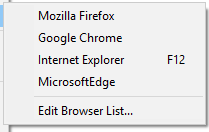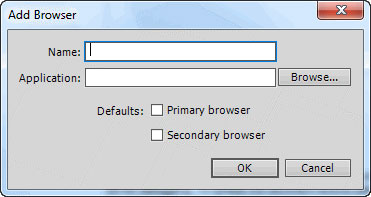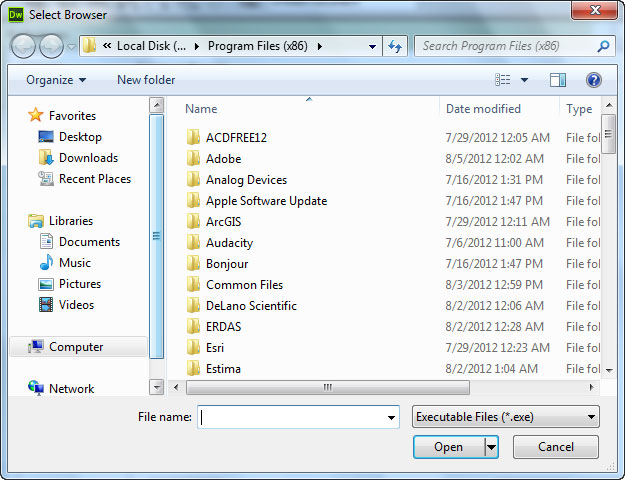These days, your website visitors have a wide variety of browser options to use, such as Firefox, Internet Explorer, Safari, Chrome, and others. Unfortunately, these browsers may not all show your page consistently. When designing web pages it is important to preview your designs in multiple browsers to check how the page will be displayed. Thankfully, Dreamweaver makes it easy for us to preview our web pages in multiple browsers. In fact, you can specify up to twenty different browsers in its Real-time Preview feature.
To add a browser in Dreamweaver, you need to have it installed on your computer. When Dreamweaver is installed, it attempts to locate all installed web browsers. However, you can also add browsers manually by following the instructions below.
Step1. To access the Real-time preview settings, on the Menu bar,
Click File, Click Real-time Preview, Click Edit Browser List...
Browsers that are already available in Dreamweaver are listed in this dialog box.
Step2. To find the browser you want to add, from the Real-time Preview options, above the list of Browsers,
Click File, Click![]()
Step3. To identify the desired brower, next to the Application Field
Click Browse.
Here are the file paths on Windows 10 (64 bit) for a few different browsers:
- Internet Explorer – C:\Program Files (x86)\Internet Explorer\iexplore.exe
- Mozilla Firefox – C:\Program Files (x86)\Mozilla Firefox\firefox.exe
- Opera – C:\Users\username\AppData\Local\Programs\Opera\launcher.exe
- Google Chrome – C:\Program Files (x86)\Google\Chrome\Application\chrome.exe
For Opera the username would be replaced with the name you are logged in to the computer with. Also, be aware that by default the AppData folder is hidden. If you need help to make hidden files visible, see Show Hidden Files and Folders in Windows 7, 8 or 10.
Here are the file paths on Mac OSX 10.74 (Lion) for a few different browsers:
- Safari – Macintosh HD:Applications:Firefox.app
- Firefox – Macintosh HD:Applications:Safari.app
Step4. To select the browser,
double click on the .exe or .app file.

Step5. To assign a keyboard shortcut for this browser, if necessary,
Click the checkbox for Primary or Secondary browser.
NOTE: You can only have one Primary browser, and one Secondary browser.
Step5. To finish adding the browser, at the bottom of the Preferences window,
Click OK
Step6. To open a page in a browser,
Click File, point at Real-time Preview, Click the browser name.





